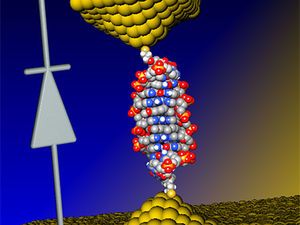Apr 5, 2016
World’s Smallest Diode Is Made of DNA
Posted by Shailesh Prasad in categories: biotech/medical, computing, electronics, genetics
Diodes —also known as rectifiers—allow electric current to flow in just one direction. More than 40 years ago, scientists proposed miniaturizing diodes and other electronic components down to the size of single molecules, an idea that eventually helped give birth to the field of molecular electronics, which could help push computing beyond the limits of conventional silicon devices. [See “Whatever Happened to the Molecular Computer?” IEEE Spectrum, October 2015]
Scientists at the University of Georgia and Ben-Gurion University of the Negev in Israel used DNA to fashion the new diode. The breakthroughs in genetics developed to sequence the human genome have now made it relatively easy to precisely manufacture and manipulate DNA, which makes the molecule a leading candidate for use in molecular electronics.
DNA’s double helix is made of paired strands of molecules known as bases. The new diode is only 11 base pairs long. (Typically, DNA is 0.34 nanometers long per base pair.)

















